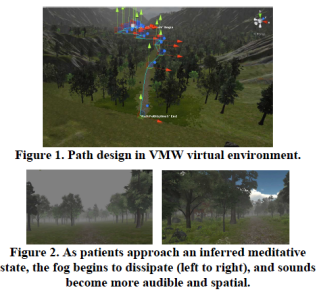[Team Project] This project introduces a VR system designed for chronic pain patients. The system incorporates biofeedback sensors, an immersive virtual environment, and stereoscopic sound titled the Virtual Meditative Walk (VMW). It was designed to enable chronic pain patients to learn Mindfulness-based stress reduction (MBSR), a form of meditation. By providing real-time visual and sonic feedback, VMW enables patients to learn how to manage their pain.
[My Role] Developer, VR Environment Designer, and Researcher
Problem
Because the nature of chronic pain is complex, pharmacological analgesics are often not enough to achieve an ideal treatment plan. Virtual Reality (VR) technologies have emerged within medical research in recent years for treating acute pain, and proved to be an effective strategy based on pain distraction. Hoffman et al. convincingly demonstrated that immersive Virtual Reality (VR) is an effective way to manage attention in computer-generated virtual places as a form of pain distraction. Thus, VR can be used as a powerful pain control technique and tool for patients to manage and alleviate their acute or short-term pain. However, it is not yet known if the analgesic effects of VR persist beyond the VR sessions. No peer reviewed user studies have yet been published to investigate whether VR is helpful for managing chronic pain on a long-term scale.
Method
The design of the Virtual Meditative Walk (VMW) provides a peaceful, non-distracting and safe environment for users to immerse themselves in as they learn to achieve a stable meditative practice as they learn to control (or exert agency over) the physiological aspects that are necessary to achieve the positive effects of MBSR. The VMW is a VE where participants immersed in the virtual reality find themselves “walking” in a beautiful forest composed primarily of a deciduous forest and undergrowth. The surrounding area is relatively mountainous, reminiscent of the trails found along the northwest coast of North America. The camera slowly moves along a worn dirt pathway, as if the user is walking. This allows patients to explore the forest without requiring physical distractions or attention in order to achieve further passage (see Figure).
A proof-of-concept user study was conducted to investigate the effectiveness of the VR system with chronic pain patients in clinical settings. The participants who were included comprised thirteen patients from the Greater Vancouver area; each had a diagnosis of chronic pain. Six participants were randomly assigned to the control group, and the other seven were assigned to the VR group.
Findings
Results show that the VMW was more effective in reducing perceived pain compared to the non-VR control condition. Compared to the control group, the VR group experienced a reduction of pain, on average, equalling 2.6 on the NRS scale.
It is promising to examine the pain reduction reported by participants in the VMW study, as the impact the VR had on chronic pain patients occurred after such a short amount of time.
Contributions
This approach could be an effective nonpharmacological alternative or supplementary method to existing pain management strategies. By teaching mindfulness meditation to patients in this context, we believe that pain patient health may be improved over time.
PuBLICATIONS
Gromala, D., Tong, X., Choo, A., Karamnejad, M., & Shaw, C. D. (2015, April). The virtual meditative walk: virtual reality therapy for chronic pain management. In Proceedings of the 33rd Annual ACM Conference on Human Factors in Computing Systems (pp. 521-524).
Back to Projects.


